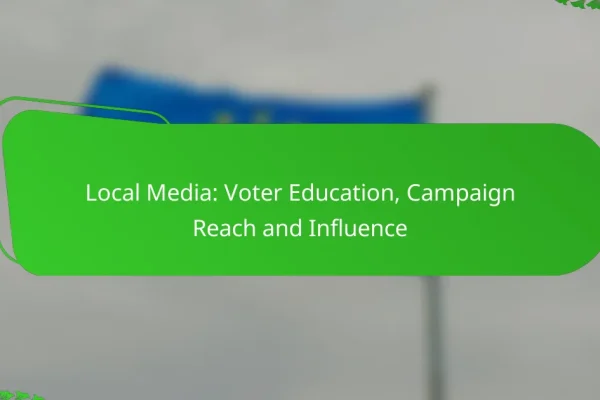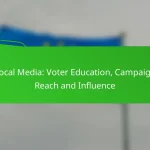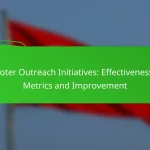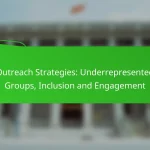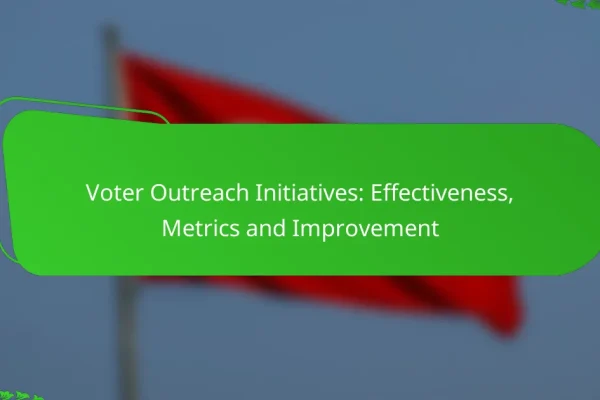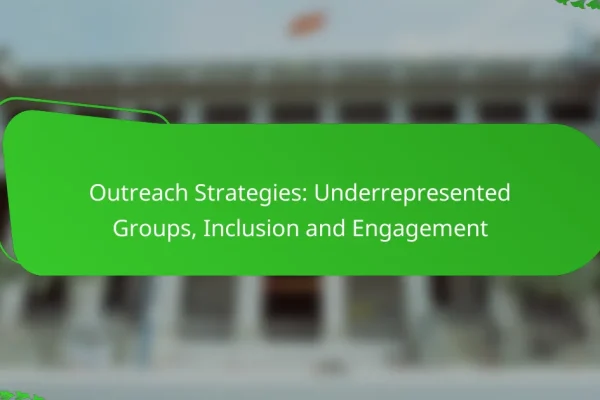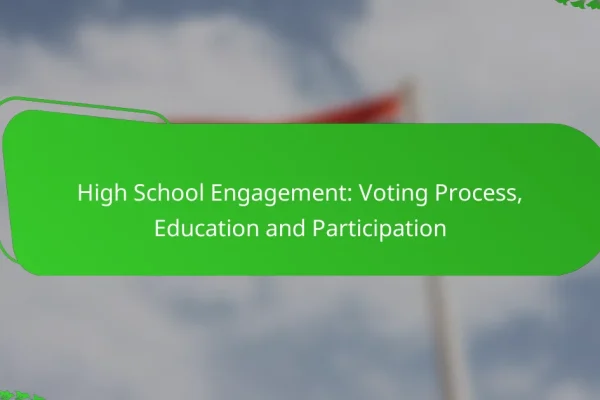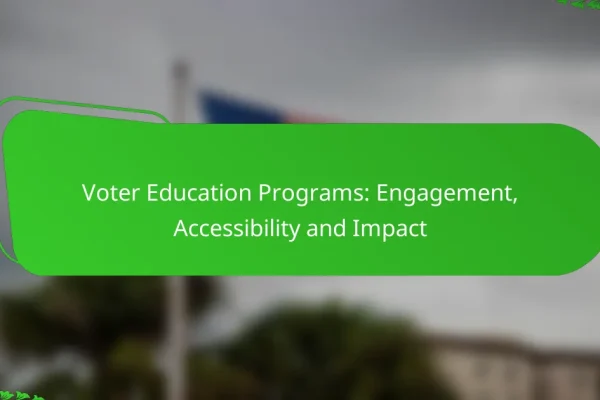How can voter education improve participation in elections?
Voter education enhances participation in elections by informing citizens about their voting rights and the electoral process. When individuals understand how to vote and the importance of their participation, they are more likely to engage in elections.
Increased awareness of voting rights
Understanding voting rights is crucial for encouraging participation. Many citizens are unaware of their rights, such as the ability to vote without discrimination or the provisions for absentee voting. Educational initiatives can clarify these rights, empowering individuals to exercise them confidently.
Programs that focus on voter rights can include workshops, informational pamphlets, and online resources. These tools help demystify the voting process and ensure that everyone knows their entitlements, which can lead to higher turnout rates.
Understanding the voting process
Comprehending the voting process is essential for effective participation. Voter education can cover how to register, where to vote, and what identification may be required. Simplifying these steps can reduce confusion and anxiety around voting.
For example, providing clear instructions on how to register online or in-person, along with deadlines, can significantly increase the number of registered voters. Additionally, explaining the voting methods available, such as early voting or mail-in ballots, can help individuals choose the option that best suits their needs.
Engagement through community programs
Community programs play a vital role in fostering voter engagement. Local organizations can host events that promote discussion about the importance of voting and provide resources for potential voters. These initiatives can create a sense of community and shared responsibility towards civic engagement.
Examples of effective community programs include voter registration drives, informational sessions at local libraries, and partnerships with schools to educate young voters. By making voting a community effort, these programs can significantly boost participation rates during elections.
What are effective outreach strategies for voter education?
Effective outreach strategies for voter education include a variety of methods that engage and inform the community about the voting process. These strategies aim to increase voter participation by providing clear information and resources that empower individuals to exercise their rights.
Workshops and seminars
Workshops and seminars are interactive sessions that educate participants about the voting process, including registration, ballot information, and voting rights. These events can be held in community centers, schools, or online, making them accessible to a wider audience.
To maximize impact, consider tailoring the content to specific demographics, such as first-time voters or non-native speakers. Providing materials in multiple languages can also enhance understanding and participation.
Social media campaigns
Social media campaigns leverage platforms like Facebook, Twitter, and Instagram to disseminate information quickly and effectively. Engaging posts, infographics, and videos can capture attention and encourage sharing, which amplifies reach.
When creating a campaign, focus on clear messaging and calls to action, such as reminders about registration deadlines or polling locations. Using hashtags can help track engagement and foster community discussions around voter education.
Partnerships with local organizations
Forming partnerships with local organizations can enhance voter education efforts by tapping into established networks. Collaborating with schools, nonprofits, and civic groups can provide additional resources and credibility to outreach initiatives.
These partnerships can facilitate joint events, share educational materials, and reach diverse populations. It is essential to align goals and ensure that all partners are committed to promoting accurate and unbiased information about voting.
How can technology enhance voter education?
Technology can significantly enhance voter education by providing accessible and timely information through various digital platforms. These tools help demystify the voting process, making it easier for citizens to understand their rights and responsibilities.
Mobile apps for voter information
Mobile applications designed for voter information offer users easy access to essential details about upcoming elections, polling locations, and registration deadlines. Many of these apps provide notifications and reminders, ensuring that users stay informed about critical dates.
Examples of popular voter information apps include Vote.org and BallotReady, which allow users to check their registration status and learn about candidates and measures on their ballots. When selecting an app, consider its user ratings and the comprehensiveness of the information it provides.
Online resources and webinars
Online resources, including websites and webinars, serve as valuable tools for voter education. These platforms often feature guides on the voting process, explanations of ballot measures, and insights into local election laws.
Organizations like the League of Women Voters and local election offices frequently host webinars that cover topics such as how to vote by mail or understand voter ID requirements. Participating in these sessions can help clarify any uncertainties and empower voters to make informed decisions.
Virtual town halls
Virtual town halls allow voters to engage directly with candidates and elected officials, fostering a deeper understanding of their positions and policies. These online events can be more accessible than traditional town halls, as they eliminate geographical barriers and often allow for real-time questions.
To participate effectively, look for announcements on social media or local news outlets about upcoming virtual town halls. Prepare questions in advance to ensure that you gain the most from these interactions, and take notes on key points that resonate with your voting priorities.
What role do schools play in voter education?
Schools play a crucial role in voter education by providing students with the knowledge and skills necessary to participate in the democratic process. Through various programs and initiatives, schools can foster civic engagement and empower young people to become informed voters.
Civics education curriculum
A robust civics education curriculum is essential for teaching students about their rights and responsibilities as citizens. This curriculum typically covers topics such as the structure of government, the electoral process, and the importance of voting. Schools should aim to integrate practical activities and discussions to make the learning experience engaging and relevant.
In many regions, state standards require a certain number of hours dedicated to civics education, ensuring that students receive a foundational understanding of democracy. Schools can enhance this curriculum by inviting guest speakers from local government or civic organizations to share real-world insights.
Student-led voter registration drives
Student-led voter registration drives are effective ways to encourage peers to register and participate in elections. These initiatives can be organized during school events or through dedicated campaigns, often involving collaboration with local election offices. Empowering students to take the lead fosters a sense of ownership and responsibility in the electoral process.
Schools can provide resources and support for these drives, such as informational materials and access to online registration tools. It is important to ensure that students understand the registration requirements in their state, including deadlines and identification needed.
Engagement with local elections
Engaging students with local elections helps them understand the impact of their vote on their community. Schools can facilitate this by organizing field trips to local government meetings, hosting debates, or conducting mock elections that simulate the voting process. These activities make the concept of voting more tangible and relevant to students’ lives.
Additionally, schools can partner with local organizations to provide students with opportunities for volunteering at polling places or participating in campaign activities. This hands-on experience not only reinforces the importance of civic engagement but also helps students develop valuable skills and connections within their community.
What are the challenges in voter outreach?
Voter outreach faces several key challenges that can hinder effective communication and participation. These challenges include language barriers, access to information, and the prevalence of misinformation and disinformation.
Language barriers
Language barriers can significantly limit the effectiveness of voter outreach efforts. Many potential voters may not be fluent in the primary language used in outreach materials, which can lead to misunderstandings or disengagement.
To address this issue, outreach programs should provide materials in multiple languages that reflect the community’s demographics. Utilizing bilingual staff or volunteers can also enhance communication and ensure that non-native speakers receive accurate information.
Access to information
Access to information is crucial for informed voting, yet many individuals face obstacles in obtaining it. Factors such as lack of internet access, limited availability of printed materials, and inadequate outreach in underserved areas can all contribute to this challenge.
To improve access, organizations can partner with local libraries, community centers, and schools to distribute information. Offering workshops or informational sessions can also help reach those who may not have easy access to digital resources.
Misinformation and disinformation
Misinformation and disinformation pose significant threats to voter outreach by spreading false or misleading information about the voting process. This can create confusion and distrust among potential voters, ultimately affecting turnout.
Combating misinformation requires proactive measures, such as providing clear, accurate information through trusted channels. Engaging community leaders to disseminate correct information can also help counteract false narratives and build trust within the community.
